In trading, market participants use two contrasting types of analysis. Fundamental analysis examines market news, economic/social/political forces, and earnings data to predict how an asset’s price will move. Technical analysis, on the other hand, uses charts and various other technical indicators to forecast market conditions. One of the essential tools used for technical analysis in securities trading is the average directional index (ADX). Its primary incentive is to determine when the price is trending strongly. In many cases, it is considered to be the ultimate trend indicator.
The following guide will examine the ADX, what it is and what it measures, how to understand the indicator on charts and interpret those findings, as well as the pros and cons of using this technical analysis tool.
Best Crypto Exchange for Intermediate Traders and Investors
-
Invest in cryptocurrencies and 3,000+ other assets including stocks and precious metals.
-
0% commission on stocks - buy in bulk or just a fraction from as little as $10. Other fees apply. For more information, visit etoro.com/trading/fees.
-
Copy top-performing traders in real time, automatically.
-
eToro USA is registered with FINRA for securities trading.
What is the average directional index?
Generally, the ADX includes three separate lines as two other indicators accompany it: the positive directional indicator (+DI) and the negative directional indicator (-DI). These lines help traders assess whether to take a long or a short trade or restrain from making a trade at all.
ADX values range between 0 and 100, where high numbers imply a strong trend, and low numbers imply a weak trend. According to Wilder, the trend has strength when ADX is above 25; if ADX is below 20, the trend is weak.
ADX calculations are based on a moving average of a price range expansion over a specific time period to quantify trend strength. The default setting recommended by Wilder is 14 bars, although other timeframes can be implemented.
How to use ADX indicator?
ADX indicator particularly effective when used in conjunction with momentum trading strategies within the stock market and forex trading. This is because solid trends are typically more apparent within highly liquid markets, so the trader can ride the price trend smoothly until it ends. As a result, the ADX indicator is one of the most popular and effective trend indicators, especially when used alongside similar tools.
Read also:
What is Value Investing?
What is Momentum Investing?
How to Buy and Sell Stocks?
Dividend Investing for Beginners
10 Best Stock Trading Books for Beginners
15 Top-Rated Investment Books of All Time
Recommended video: Beginner’s Guide to the Average Directional Index Indicator
History of the average directional index
The average directional index or ADX indicator was developed in 1978 by J. Welles Wilder for analyzing commodity price charts but can be easily applied to different markets and timeframes.
J. Welles Wilder, born in 1935, was an American mechanical engineer turned real estate developer, best known, however, for his technical analysis work.
Wilder can be considered the father of several technical indicators that are now regarded as the core principles of technical analysis software. On top of the ADX, these include the Average True Range, the Relative Strength Index (RSI), and the Parabolic SAR.
ADX calculation
To calculate +DI and -DI, one needs price data consisting of high, low, and closing prices each period (typically each day). One first calculates the directional movement (+DM and -DM):
Up-move = today’s high − yesterday’s high
Down-move = yesterday’s low − today’s low
Positive directional movement (+DM) occurs when: the current high – previous high > previous low – current low. Otherwise, it equals zero. A negative directional movement (-DM) occurs when: previous low – current low > current high – previous high. Otherwise, it equals zero.
After selecting the number of periods (Wilder recommended 14 days originally), we get:
+DI = the smoothed moving average of +DM divided by average true range times 100
-DI = the smoothed moving average of -DM divided by average true range times 100
If the smoothed moving average is calculated over the chosen number of periods, and the average true range is a smoothed average of the true ranges, then:
ADX = the smoothed moving average of the absolute value of (+DI − -DI) divided by (+DI + -DI) times 100
The average directional index formula is as follows:

Although being familiar with the formula can come in handy, measuring ADX calculations yourself is unnecessary, as most online trading systems will automatically calculate technical indicators.
Best Crypto Exchange for Intermediate Traders and Investors
-
Invest in cryptocurrencies and 3,000+ other assets including stocks and precious metals.
-
0% commission on stocks - buy in bulk or just a fraction from as little as $10. Other fees apply. For more information, visit etoro.com/trading/fees.
-
Copy top-performing traders in real time, automatically.
-
eToro USA is registered with FINRA for securities trading.
How to read and interpret the average directional index
Firstly, the ADX is used to determine if a market is even trending rather than simply fluctuating within a range. Secondly, to determine the trend’s strength in a trending market. Finally, it is also often used, as other momentum indicators are, to indicate a potential market reversal or trend change.
The ADX is a lagging indicator, meaning a trend must have established itself for the indicator to generate a signal that a trend is underway. ADX values range between 0 and 100, in which high numbers signify a strong trend and low numbers suggest a weak trend.
Trend strength readings:
- ADX below 20: weak trend, the market is currently not trending;
- ADX crosses above 20: forecasts that a new trend is surfacing. Traders may begin placing sell or buy orders in the trend’s direction;
- ADX between 20 and 40: a growth between 20 and 40 is considered a confirmation of an emerging trend. Traders may use this an opening to buy or short sell in the trend’s direction;
- ADX above 40: very strong trend;
- ADX crosses 50: extremely strong trend;
- ADX crosses 70: an extremely scarce occasion called a “Power Trend.”
The chart below shows the average directional index indicating an increasingly strong uptrend as average directional index readings rise from below 10 to nearly 50.
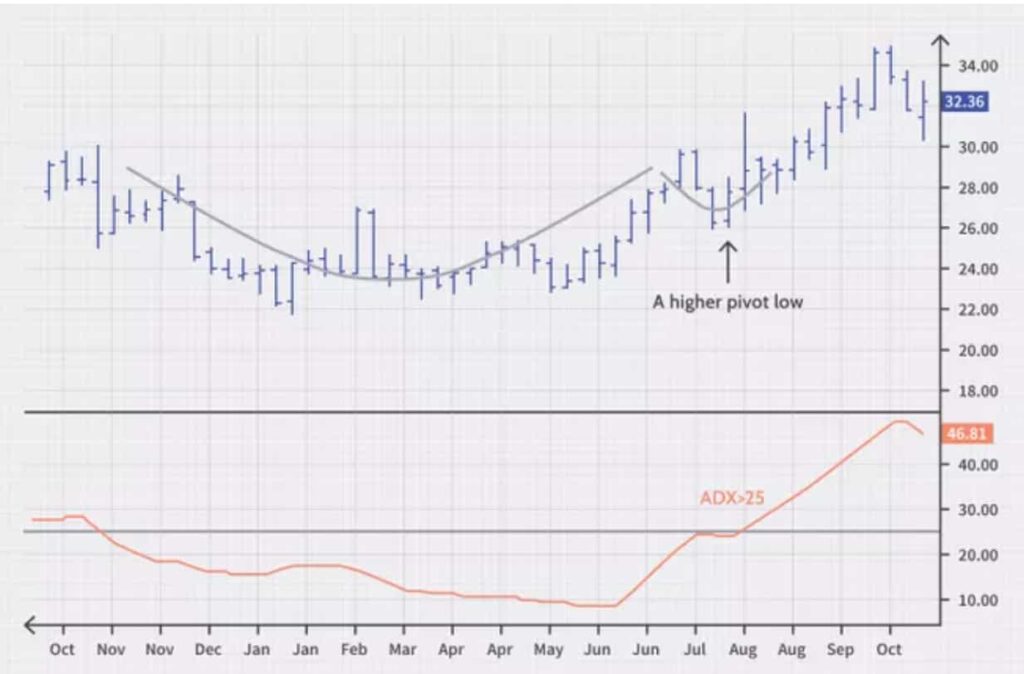
Important
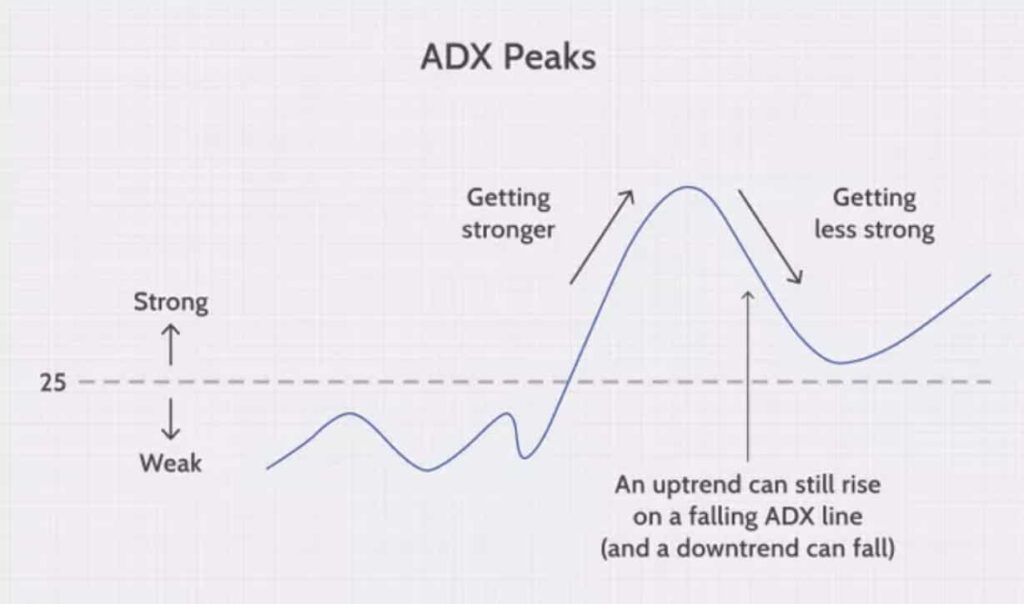
Negative directional indicator (-DI) and positive directional indicator (+DI)
The ADX is a momentum indicator that is often used along with two other momentum indicators: the negative directional indicator (-DI) and positive directional indicator (+DI). Instead of trend strength, these directional movement indicators help identify direction. The ADX is a composite average of the +DI and DI indicators.
Prices are increasing when the +DMI reads above the -DMI, signaling an uptrend. Prices are falling when the negative DMI reads above the positive DMI, signaling a downtrend.
Crossovers
Directional movement indicator crossovers can be used to estimate the performance of a security and predict coming changes in a trend, such as reversals or breakouts. They can create trade signals for potential opportunities.
For instance, when the +DI line crosses past the -DI line and the ADX reading is above 20, then some traders may see this as a lucrative opportunity to buy and go long on an asset (bull market DI crossover). Alternatively, when the -DI crosses past the +DI line, and the ADX reading is above 20, then they may see this as an excellent opportunity to sell and go short (bear market DI crossover).
Crossovers can be used to signal entry points and exit points and caution traders to wait to enter a position until the market is more steady or profitable.
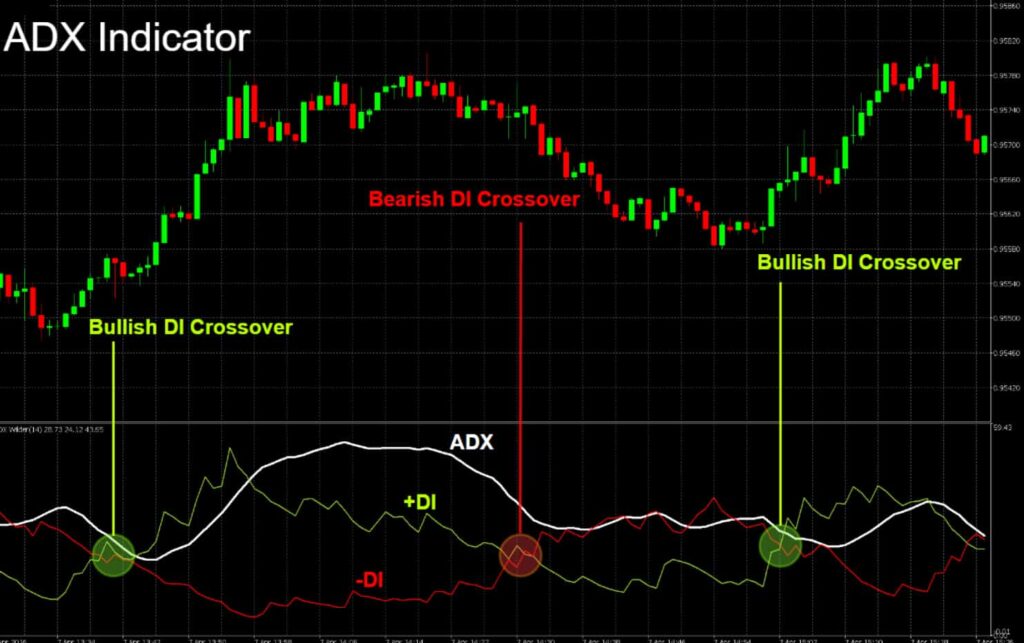
How to look for trend momentum
The sequence of ADX peaks is a visual indication of overall trend momentum, demonstrating when the trend is gaining or losing momentum – the acceleration of price. A succession of higher ADX peaks indicates trend momentum is rising. At the same time, a series of lower ADX peaks shows decreasing momentum.
Generally, ADX peaks above 25 are considered solid, even if they are lower. In an uptrend, the price can still rise on a falling ADX momentum because overhead supply is used up as the trend progresses.
Being aware of a rising trend momentum gives traders confidence to keep the position instead of exiting before the trend has ended. Similarly, a series of lower ADX peaks can signal the trader to keep an eye on price and ensure that their risk-management technique is in place. Since, of course, the most profitable trading decisions are made on objective signals and not emotion.
ADX as a signal for divergence
In addition, ADX can reveal momentum divergence that can signal an impending trend change or market reversal. Negative divergence or non-confirmation occurs when price makes a higher high and ADX makes a lower high. As a rule, divergence is a warning that trend momentum is changing rather than a signal for a reversal. In which case, it may be appropriate for the trader to tighten the stop-loss or take partial profits.
Finally, assess and manage your risk if you see the trend change character at any point, as divergence can lead to trend continuation, consolidation, correction, or reversal.
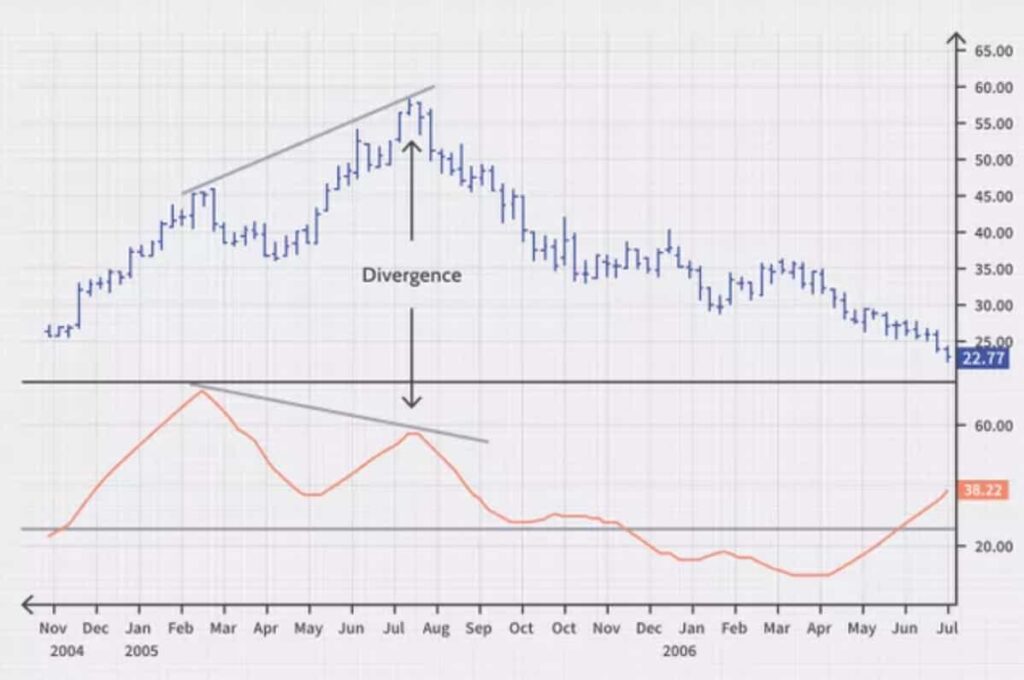
ADX trading strategy
Using the ADX indicator can provide us with information that is missing from a basic price chart. For example, the ADX helps determine support and resistance levels, which show whether a price is staying within its trend range or significant price fluctuations that may lead to a breakout.
Breakouts happen when an asset’s price has sudden momentum, generally due to increased supply and demand. The difference creates price momentum, whether it is more demand than supply or more supply than demand.
Even though breakouts are not hard to spot, they often fail to progress or end up being a trap. Yet, the ADX can tell you if they’re valid by showing when ADX is sufficiently strong for the price to trend following the breakout.
ADX strategies are helpful for the following:
- Identifying when there could be a breakout;
- Indicating an appropriate method for a trader to use.
For example, when ADX rises from below 25 to above 25, the price is strong enough to continue in the breakout direction.
Using ADX strategy with forex
As mentioned earlier, the ADX is commonly used within highly liquid markets. Arguably the most liquid financial market — forex trading. The ADX indicator, when applied to currency trading, helps measure a currency pair’s strength to see whether the instrument will increase or decrease in price. Using this method will reflect its trend momentum and indicate the presence of either an upward or downward trend.
Using ADX strategy with stocks
The same strategy also applies to the stock markets. Applying an ADX strategy to evaluate the performance of shares allows traders to see when one is overbought or oversold, according to the sequence of lowering peaks.
The stock market can be immensely volatile, and share prices are often influenced by fundamental factors and economic events such as news reports and performance documents. Subsequently, having an effect on a stock’s price in a rapid timeframe, making it more difficult to use technical analysis tools to predict share value direction. For this reason, the ADX indicator and other trend-based indicators do not work as well for the share market as for other financial instruments.
The ADX vs. the Aroon indicator
The Aroon indicator is another indicator for trend strength that shares resemblances with the ADX. The two indicators are alike in that they both have lines that represent positive and negative directional movement, which helps determine trend direction. However, instead of three lines, the Aroon indicator has two lines: an ‘Aroon up’ line that measures the strength of the uptrend, and an ‘Aroon down’ line that measures which measures the strength of the downtrend.
Like the ADX, crossovers of the two Aroon lines can signal trend changes. Still, as the calculations of each indicator are different, crossovers on each indicator will happen at different periods.
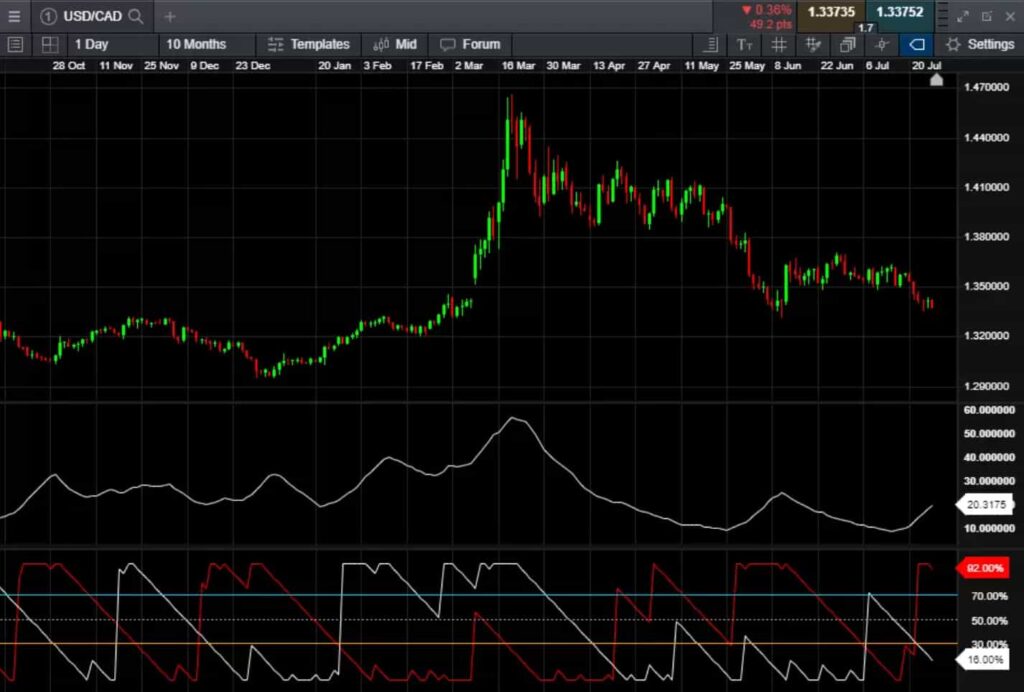
Pros & cons of the average directional index
As with most other technical analysis tools, the average directional index, too, comes with its own set of unique advantages and disadvantages. Therefore, it’s crucial to understand where this trend indicator excels and where it fails to get the most out of its use.
Pros
- Excellent tool for measuring trend strength;
- Alerts about changes in trend momentum;
- Useful at finding find the strongest trends;
- Good at identifying trending conditions in a variety of instruments, including forex and stocks;
- Helpful at confirming the validity of a trend breakout;
- The indicator is beneficial for both day trading and swing trading.
Cons
- ADX is a lagging indicator that follows price;
- Can deliver many false signals when used on shorter timeframes;
- It doesn’t incorporate all of the data necessary for a thorough price action analysis, so it’s advised to use it in combination with other indicators.
In conclusion
To sum up, the average directional index is one of the most reliable trend strength indicators and has helped many traders determine ranging markets correctly and avoid being enticed into buying false breakouts or investing into markets that are essentially flat and going nowhere.
While the ADX calculations are complex, the interpretation is straightforward, but successful implementation takes practice. Like any technical analysis tool, the ADX should be combined with price analysis and potentially other indicators to help filter signals and manage risk.
Best Crypto Exchange for Intermediate Traders and Investors
-
Invest in cryptocurrencies and 3,000+ other assets including stocks and precious metals.
-
0% commission on stocks - buy in bulk or just a fraction from as little as $10. Other fees apply. For more information, visit etoro.com/trading/fees.
-
Copy top-performing traders in real time, automatically.
-
eToro USA is registered with FINRA for securities trading.
Disclaimer: The content on this site should not be considered investment advice. Investing is speculative. When investing, your capital is at risk.
FAQs about the average directional index
What is the ADX?
The average directional index (ADX) is a technical analysis tool for determining the strength of a trend. Generally, the ADX is accompanied by two other indicators: the positive directional indicator (+DI) and the negative directional indicator (-DI). These lines help traders assess whether to take a long or a short trade or restrain from making a trade at all.
How to use average directional movement index?
Firstly, the ADX is used to determine if a market is even trending rather than simply fluctuating within a range. Secondly, to determine the trend’s strength in a trending market. Finally, it is also often used, as other momentum indicators are, to indicate a potential market reversal or trend change.
How to read the ADX?
ADX values range between 0 and 100, where high numbers imply a strong trend and low numbers imply a weak trend. Many traders believe ADX readings above 25 indicate a strong enough trend for trend-trading strategies. On the other hand, when ADX is below 25, many will avoid trend-trading strategies.
What are the ADX's disadvantages?
The ADX is a lagging indicator, meaning a trend must have established itself for the ADX to generate a signal that a trend is underway. Moreover, the ADX indicator alone won’t supply enough data to be used on its own and can provide false signals when used on shorter periods.
How to use ADX indicator for day trading?
For day trading, the ADX indicator can be a valuable tool to identify strong trending stocks. Look for ADX values above 25-30, and combine it with directional movement indicators to determine the trend direction. When +DI is above -DI and ADX is rising, consider long trades, and when -DI is above +DI and ADX is rising, consider short trades. ADX helps confirm trend strength and manage risk, but it should be used in conjunction with other indicators and real-time price action for precise day trading decisions.






